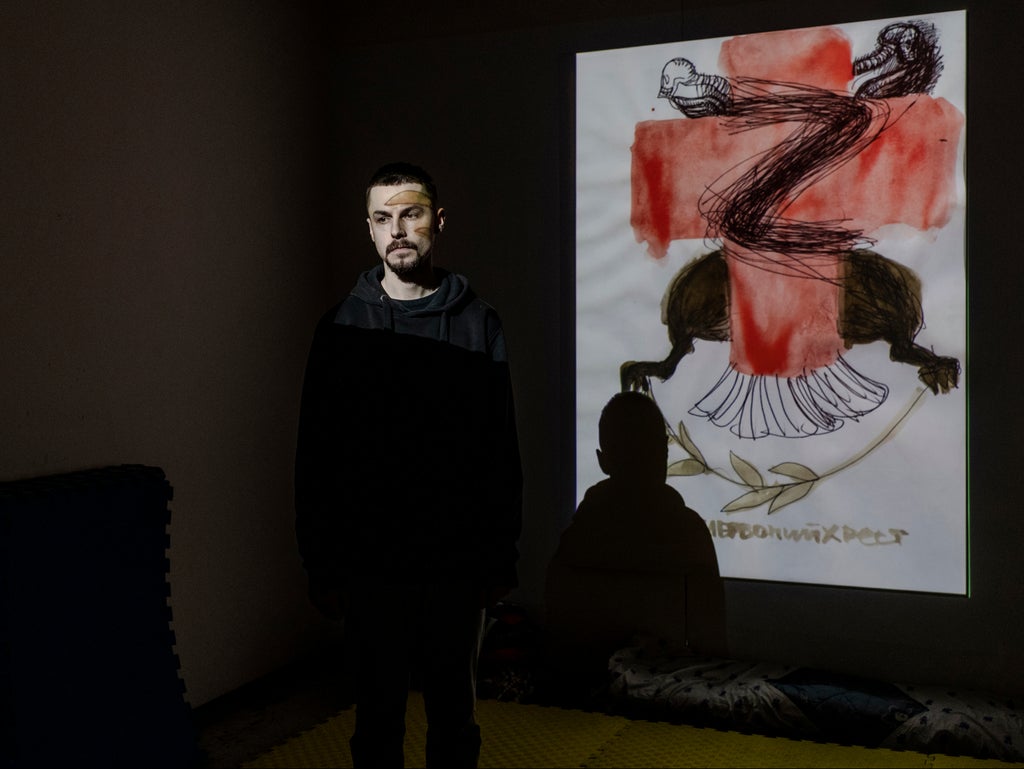
When one of the most renowned visual artists in Ukraine left her home in Kyiv in the first days of the Russian invasion, she went to the Lviv Municipal Art Centre. Vlada Ralko settled in among the hundreds of displaced people who sheltered at the facility last month.
Now it is an art gallery again, showcasing the wartime work of artists from around Ukraine, including Ms Ralko, who spent several weeks here in silence, churning out more than 100 drawings depicting the invasion.
During the same period, Stepan Burban, a rapper from Lviv, added to his soon-to-be-released album a track that amounts to a call to arms for Ukrainians. He swapped out the planned cover art for one of the recent drawings by Ms Ralko, showing a bomb landing on a crushed womb.
"The first week I felt very angry," Mr Burban said. "Now it is just a constant hate."

Ukrainian daily life away from the front lines in the last two months has seen a wholesale rejection of all things Russian paired with a need to tell the world, especially Russians, what has happened here. Ukrainian contemporary artists, who for years have fought an uphill battle against a Soviet legacy of rigidity governing freedom of expression, now find themselves at the forefront of that storytelling mission.
Street posters in Lviv, which has become a gathering place for displaced artists from around the country, depict Ukrainians as white knights, noble siege defenders in mediaeval armour or men on horseback wielding tridents. Russians are represented as bloodthirsty bears, hissing serpents, dead-eyed zombies and red-skinned goons.
While the artistic reaction in metropolitan centres across Ukraine has been swift, arrivals from the east lament the absence of a similar response to Russian aggression eight years ago, when the federation invaded the Crimean Peninsula and began the war in Donbas.
Vitaliy Matukhno was a teenager in the Luhansk region of eastern Ukraine during the annexation of Crimea. He spent his formative years watching the separatists and Russian elements subdue Ukrainian authority and suppress any hint of Western culture.

"They destroyed our city from the inside so people would remember things back in the Soviet Union were better," said Mr Matukhno, who is now 23.
Before the invasion, Mr Matukhno was an activist, artist and publisher. He threw rave parties, planned art festivals and published a zine featuring the work of his peers. Months ago, at an abandoned television station in Lysychansk, he discovered a trove of recordings from 2002. He plans to create a compilation of scenes of life in the region before the war in Donbas.
"You have these European liberals saying, ‘We want peace,’" Mr Matukhno said. "They are trying to create a dialogue between Russians and Ukrainians. Every Russian is guilty for what is going on right now. We have a right to hate them. They are destroying my country."
At the Lviv National Academy of Arts, students turned a campus bomb shelter into an art gallery, in part to boost morale and in part to entice apathetic and fatalistic college students to actually use the shelter when the air raid sirens wailed across the city. Upon entering, visitors are welcomed with a red bell and sign that says "ring for Putin’s death."

The tenor of the gallery shifts as one travels down narrow corridors that bear witness to what has been lost. One exhibit asks visitors to draw something they miss from homes that many cannot return to on a tiny piece of paper and slide it into a matchbox painted with the Ukrainian flag.
One student who was in Kharkiv when bombing began recorded what he could hear from his balcony for 24 hours during the invasion. Throughout the recording, chirping birds are interrupted by explosions. Over time, moments of peace produce only anxiety, knowing the other shoe will drop again shortly.
Kharkiv State Academy of Design and Arts rector Oleksandr Soboliev is now living in Lviv and working out of an office at the academy. He said at least 30 of its more than 1,030 students are missing and unaccounted for, and one has been confirmed dead. Students have been submitting posters about the war to an initiative started by the school and working to get them seen by Russians on social media.
"Nowadays we are giving much more freedom to students in regard to black humour," he said. "In peacetime that was not allowed. Now it is the opposite, actually." A popular theme includes the words of the Ukrainian Snake Island defenders who famously said an expletive to a Russian warship. The critical ship has since sunk, and Ukraine has claimed responsibility.

Ukraine this week released a postage stamp with a drawing picturing a soldier making an obscene gesture toward the ship. At the municipal art centre, where Ms Ralko stayed before departing for Germany, and Mr Burban now works on his laptop producing music, walls that once featured exhibits on pottery and Lithuanian photography are instead covered with depictions of violence.
Among the first works that greet visitors is a drawing of children being ferried across a river by demonic boatmen. Across the hallway, a drawing of a woman cowering on the ground with four soldiers, one without pants, standing in a semicircle around her.
Mr Burban used to play music that once openly mocked Ukrainian civic leadership. That political environment seems far away now, he said. "The words from my last songs about people are not relevant anymore. Something changes because people are now united," Mr Burban said. "I don’t know what awaits us after the war. When we need to live peacefully and become devoted to some ideas and values, it becomes difficult to be that united organism."







